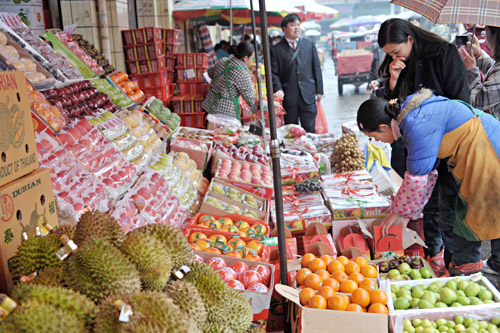|
 |
|
Customers shop at the Nanning Wuliting Vegetable Wholesale Market, the only comprehensive market for agricultural products in Guangxi Zhuang Autonomous Region, on January 1, 2010 (XINHUA) |
Every morning around 6 o'clock, Huang Shaoqun shows up at the Nanning Wuliting Vegetable Wholesale Market, the only comprehensive market for agricultural products in Guangxi Zhuang Autonomous Region, to run a fruit business with her sisters, amid noise from back-and-forth delivery trucks as well as bargaining customers.
Born to a fruit farming family in Yong Ning, currently a district of Nanning, capital city of Guangxi, Huang, 35, started her fruit business in the 1990s. Her tiny booth, located in Fruit Zone VIII, offers a wide range of imported and homegrown fruit. Most of the imported fruit, including durian, mangosteen, longan, dragon fruit and Annona, comes from ASEAN (Association of Southeast Asian Nations) member states like Thailand and Viet Nam.
"It is cheaper to buy imported fruit from Southeast Asia than before," Huang told Beijing Review. "For example, the price of Thailand mangosteen is down from more than 300 yuan ($37.5) per case to less than 150 yuan ($22)."
The lower price is driven by the construction of the China-ASEAN Free Trade Area (CAFTA), an idea that dates back to the Asian financial crisis in the late 1990s, when the then Chinese Premier Zhu Rongji reiterated China's readiness to enhance its regional ties through an ASEAN free trade area at the third China-ASEAN Summit in Manila in 1999.
In October 2003, tariffs on some 188 fruits and vegetables were eliminated as China and Thailand signed an agreement on accelerated tariff elimination under the Early Harvest Program of the Framework Agreement on Comprehensive Economic Cooperation between ASEAN and China.
The Early Harvest Program, part of the FTA framework agreement signed by China and ASEAN in 2002, was officially launched on January 1, 2004, scrapping tariffs on about 600 agricultural imports on both sides by 2006. The result was impressive, as the fruit trade between China and ASEAN hit $460 million in 2004 alone, an increase of 27.8 percent compared with the previous year.
Statistics from the Chinese Ministry of Commerce show that bilateral trade volume between China and ASEAN rose from $78.2 billion in 2003 to $231.1 billion in 2008, with an annual average increase of 24.2 percent. China has risen from ASEAN's sixth largest to third largest trade partner, while ASEAN has risen from China's fifth largest trade partner to fourth.
CAFTA, which started operation on January 1, 2010, covers a population of 1.9 billion and involves about $4.5 trillion in trade volume. It is the world's largest FTA for developing countries and the third largest FTA after the North American Free Trade Area and the European Union. The average tariff on goods from ASEAN countries to China has fallen from 9.8 percent to 0.1 percent.
Yi Xiaozhun, China's Vice Commerce Minister, said the FTA is "mutually beneficial" at a ceremony marking the establishment of CAFTA in Nanning on January 7.
"With full consideration of the economic development levels and market capacities of both sides, the FTA will advance regional economic integrity by eliminating barriers to trade and investment," Yi said. "Both sides should make full use of investment funds and other resources and step up infrastructure construction to meet the needs of further trade cooperation."
Huang believes that her fruit business will be better off under CAFTA, although she is unable to tell what exactly the establishment of the FTA will bring to her.
"There haven't been too many changes in business so far, because CAFTA was formally launched just days ago. It will take time to implement policies. I can understand that," Huang said. "I hope that we can benefit more from CAFTA, because the cheaper the price of fruit, the more buyers there are, and the better my business!" | 